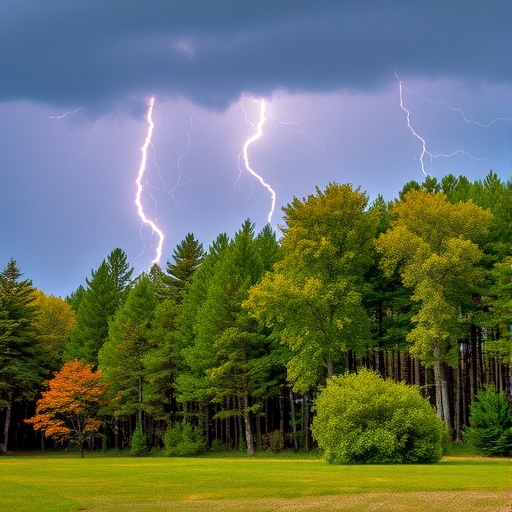
The Hidden Forest Killer: Lightning’s Massive Impact on Global Tree Mortality and Carbon Emissions
Lightning, an awe-inspiring natural phenomenon, is increasingly being recognized for its profound yet underappreciated effects on forest ecosystems worldwide. Recent research spearheaded by scientists at the Technical University of Munich (TUM) has revealed that lightning is a far more significant agent of tree mortality than previously understood. Utilizing advanced computational modeling and global observational data, the researchers estimate that roughly 320 million trees succumb to lightning strikes annually. This revelation challenges earlier assumptions and compels the scientific community to reconsider lightning’s ecological role in forest dynamics and carbon cycling.
For years, data on lightning-induced damage to forests remained fragmented and regionally confined, primarily relying on field observations from select forests. The subtlety and sporadic nature of lightning damage—ranging from bark scars to internal trunk damage leading to delayed mortality—have impeded comprehensive assessments. The TUM team overcame this limitation by employing a novel mathematical model that integrates wide-ranging global lightning activity data with vegetation dynamics. This approach not only estimates the numbers affected on a global scale but also maps out the geographic distribution of vulnerability and the consequent impacts on forest structure.
.adsslot_RSJk8NGPoO{width:728px !important;height:90px !important;}
@media(max-width:1199px){ .adsslot_RSJk8NGPoO{width:468px !important;height:60px !important;}
}
@media(max-width:767px){ .adsslot_RSJk8NGPoO{width:320px !important;height:50px !important;}
}
ADVERTISEMENT
Lightning strikes disrupt the physical integrity of trees, inducing a form of damage that can be fatal in the weeks, months, or even years following the initial event. The researchers’ model captures the cumulative effect of these strikes, identifying trees so severely impacted that death is eventually inevitable. Notably, their calculations exclude trees lost due to wildfires ignited by lightning, focusing solely on direct mortality resulting from the electrical discharge itself. This distinction highlights a multifaceted role of lightning as both a direct and indirect driver of forest biomass loss.
The implications of this lightning-induced mortality extend well beyond individual trees. On an ecosystem level, the researchers estimate that this mortality corresponds to an annual biomass loss of between 2.1% and 2.9% of global plant biomass. When translated into atmospheric carbon flux, this biomass decay releases between 0.77 and 1.09 billion tons of CO₂ per year, a figure that astonishingly parallels emissions from living-plant biomass combustion in wildfires, which stands at approximately 1.26 billion tons annually. While total wildfire CO₂ emissions are much higher—about 5.85 billion tons per year due to consumption of dead wood and soil organic matter—these findings position lightning as a non-negligible contributor to carbon cycling.
Geographically, lightning-induced mortality is most prevalent in tropical forests, which exhibit high lightning flash densities and immense biomass stocks. However, the modeling signals a potential shift in this pattern with climate change projections. Increasing lightning frequencies are anticipated primarily across mid- and high-latitude regions, encompassing temperate and boreal forests. These forest types, traditionally less impacted by lightning, could face rising mortality rates, thereby altering forest composition, carbon sequestration patterns, and ecosystem resilience. Such shifts present complex challenges for forest management and climate mitigation strategies.
Underlying this study is the integration of a globally recognized vegetation model expanded to incorporate lightning observational datasets, such as those from the Lightning Imaging Sensor (LIS) and ground-based detection systems. By marrying dynamic vegetation simulations with lightning strike probabilities, researchers acquired a nuanced perspective on how lightning patterns interact with forest distribution and vulnerability. This interdisciplinary computational framework enables scenario modeling under future climate regimes, providing actionable insights for ecologists and policymakers.
The research underscores lightning as an often-overlooked disturbance agent in climate models and forest carbon budgets. Historically, climatic factors such as temperature, precipitation, and wildfires have dominated modeling efforts, with lightning relegated to a secondary role. This new evidence advocates for the integration of lightning-strike-induced mortality rates in global vegetation and carbon dynamics models to improve predictive accuracy concerning forest health and carbon fluxes in a changing world.
Moreover, the findings speak to the resilience and adaptive capacity of forest ecosystems. The death of hundreds of millions of trees annually, especially when distributed unevenly across regions, can influence successional trajectories, species composition, and biodiversity. Some species or forest types may exhibit greater vulnerability to electrical damage, further modulating ecosystem structure over decadal timescales. The possibility of increased lightning mortality at higher latitudes might introduce novel selective pressures, potentially favoring species with greater electrical resistance or faster recovery rates.
Importantly, lightning-induced tree mortality also has ramifications for forest carbon storage potential. As trees die and decompose, carbon previously sequestered in living biomass is reintroduced into the atmosphere, affecting carbon sinks. This process could feedback into climate warming, especially if increased lightning strike frequency amplifies biomass loss. Understanding this feedback loop is critical, particularly in boreal and temperate forests which act as significant global carbon reservoirs.
The study’s computational approach presents opportunities for further refinement, such as incorporating species-specific vulnerability data, integrating post-strike disease and insect outbreak risks, and evaluating long-term forest regeneration patterns following lightning events. Expanding ground validation efforts to corroborate model outputs with high-resolution mortality data across varied ecoregions will enhance reliability and robustness.
Finally, this research highlights an emergent challenge in the nexus of forest ecology and climate science: the need to account for complex, stochastic natural disturbances like lightning when forecasting ecosystem responses to global change. As climate models continue to evolve, integrating such disturbance dynamics will be imperative to develop comprehensive, realistic projections of future forest health, carbon budgets, and biodiversity conservation strategies.
Subject of Research: Not applicable
Article Title: (Information not provided)
News Publication Date: 24-Jun-2025
Web References: DOI: 10.1111/gcb.70312
References: (Detailed references not provided)
Image Credits: (Information not provided)
Keywords: lightning-induced tree mortality, forest biomass loss, carbon emissions, computational modeling, global vegetation model, forest ecosystems, climate change, tropical forests, temperate and boreal forests, carbon cycling, disturbance ecology
Tags: advanced computational modeling in ecologyassessing lightning-induced forest damagebiomass loss due to lightningcarbon emissions from tree deathsecological role of lightning in forestsforest ecosystems and lightninggeographic distribution of lightning damageglobal tree mortality statisticsimpact of lightning on forestslightning strikes and tree mortalitytree health and lightning impactsvegetation dynamics and lightning





